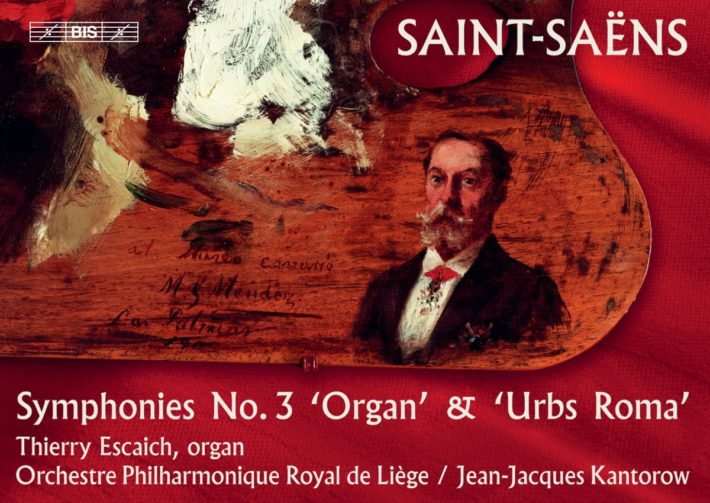This latest release completes a cycle of Saint-Saëns’ five symphonies played by the Liège Royal Philharmonic. I was greatly impressed by their previous release of the other three symphonies (reviewed here) and remain so with this release, especially its persuasive account of the early “Urbs Roma.”
The work, also known as “Symphony in F major,” was written in a little over a month in the summer of 1856. It was then submitted into a competition arranged by the Société Sainte-Cécile in Bordeaux. The society presented “keywords” meant to inspire a programmatic element for the music, thus Saint-Saëns subtitle “Urbs Roma” (City or Rome). But the composer did not leave any kind of program notes, and it seems most likely that he chose the subtitle simply to please the judges. The symphony is certainly not programmatically descriptive like similar works by Berlioz or Liszt.
What does not disappoint, especially in this new recording, is Saint-Saëns astonishing melodic fluency. The first two movements feature several attractive tunes, playful, light-hearted, and often highly chromatic, yet eminently tuneful. This is Kantorow’s second recording of the work – in the late 1990s he recorded it with the Tapiola Sinfonietta (also on BIS) – and this new reading confirms a consistency in conception and interpretative ideals. The tempos for the first two movements are nearly identical, and in both performances Kantorow elicits an airy, lithe response from his orchestra that fully capture’s the music’s playful mood and Gallic charm. By comparison, Mark Soustrot’s Malmö orchestra seems a bit too heavy, the approach strait-laced and overly serious.
Some scholars have suggested that the third movement, in F-minor, is a funeral march for a dead empire. While the composer left no such description, this is clearly music of somber atmosphere. Yet Kantorow’s new reading shaves almost 30 seconds off his already quick reading in Tapiola. But in Liège he allows himself greater room to shape the musical discourse, while the orchestra offers a wider variety of orchestral color and sophistication. The wind solos, most especially the clarinet at 3’20”, are often ravishingly beautiful.
Related Classical Music Reviews
- Review: Saint-Saëns – Chamber Works – Chamayou, Capuçon, Moreau
- Review: Saint-Saëns – Piano Concertos 3-5 – Alexandre Kantorow
- Review: Tchaikovsky – Symphony No. 5 – Tonhalle, Paavo Järvi
The fourth movement has often been criticized for not being the rousing fast and loud finale audiences expected – strange, considering how many composers before and after have also upended those expectations. The movement opens with a sweetly gentle theme, followed by variations of increasing complexity that again reveal a mastery of form and brilliant orchestration. Jean-Pascal Vachon’s excellent liner notes reveal that some scholars suggest each variation is written in the style of a different composer, but throughout the work one clearly hears the developing yet still unique voice of its composer. Kantorow secures playing of energy and technical elan, rounding off a highly accomplished reading.
Competition in the third Symphony is far fiercer – there are over 60 currently available recordings of the work, whereas there are 10 or less of the other symphonies. The same interpretive priorities hold true here: tempos are on the quick side (the opening movement’s “Allegro moderato” more “allegro” than “moderato”), orchestral texture is delivered with diamond-like clarity, and orchestral execution is consistently impressive. Brass is encouraged/allowed to play out at climaxes (after all, it is the largest brass section Saint-Saëns ever used in a Symphony), creating thrillingly sumptuous moments. (And how accurately the wind sections articulate at Kantorow’s chosen speeds.) Yet at 9’45” when the slow section begins and one senses we are breathing rarefied air, Kantorow and the orchestra establish this new atmosphere so completely, and the engineering ensures we feel the organ’s low notes as well as hear them. Control of the slow movement’s ebb and flow is masterful, the Liège strings revealing reservoirs of color that draw the listener into the emotional core of this music.
The final movement may be problematic for some. Organist Thierry Escaich honors the score by registering the organ for less power and weight on its initial entrance (the initial chord is only marked “forte”). At 1’53” the tempo surprisingly moderate – not at all what I was expecting, but it does allow for absolute clarity throughout the contrapuntal writing, more time for the winds to revel in the solos that follow, and many lustrous climaxes. At 6’39” Kantorow shifts into high gear, his Liège players momentarily scrambling to keep up – but it makes for an undeniably thrilling ending.
We now have thoroughly excellent performances of Saint-Saëns’ five symphonies in stunning surround sound. There will surely be times when one wants a more overtly Romantic approach and perhaps a more consistently opulent orchestra sound, and for those times Soustrot’s recordings with the Malmö Symphony (or better yet, Fischer’s with the Utah Symphony/Hyperion) should be at hand. But the Orchestre Philharmonique de Liège offers playing of exceptional finesse and technical elan, wedded to interpretations that are bracingly alive, and it is hard to imagine how BIS’s SACD sound could be bettered. The label must record all the composer’s tone poems with these forces – warmly recommended.

Saint-Saëns – Symphonies No. 3 & Urbs Roma
Orchestre Philharmonique de Liège
Thierry Escaich – Organ
Jean-Jacques Kantorow – Conductor
BIS, SACD 2470
Recommended Comparisons
Read more classical music reviews or visit The Classic Review Amazon store
Follow Us and Comment:
[wd_hustle id=”HustlePostEmbed” type=”embedded”]











